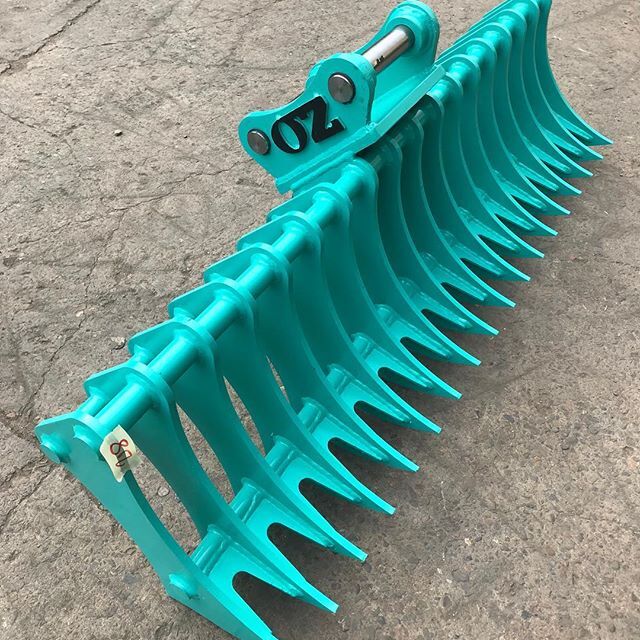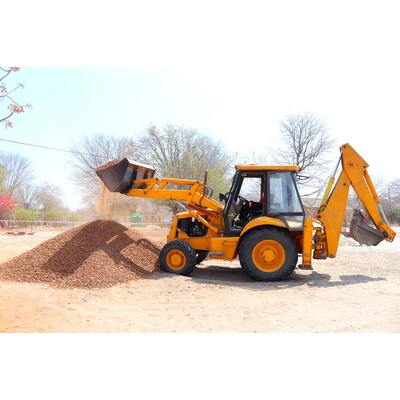Getting the right bucket for the job is crucial for any excavation. That’s why Bunyip Equipment offers a range of top-quality Oz excavator buckets to make sure that any earthmoving work you have to do is completed to the highest standard. Of course, there are many different types of excavator buckets on offer. So, we’re bringing you a list of the sorts of Oz Buckets out there, as well as how to find out which bucket you need and how to get the most out of your excavator.
Different Types of Oz Buckets
General Purpose (GP) or Digging Bucket
The GP buckets have teeth on the ends for breaking up ground, allowing for easier penetration. It’s the all-purpose bucket that can be used in numerous circumstances, such as digging through hard, rugged surfaces, hard soil or even rocks.
Oz GP buckets come with an optional side cutter designed to protect the side from premature wear so you can keep digging for longer.
Excavator Stick Rake
The stick rake uses a claw design for maximum breakout force. It can be used in either a pulling or pushing motion and is ideal for brush clearing or vegetation management, general site clearing, fast clean-ups, sorting unwanted debris and sifting soil or rocks.
Mud Bucket
Also known as sand buckets, batter buckets, trimming buckets or loading buckets, a mud bucket is wider than a GP bucket and has a smooth edge. While its design means it’s less efficient in areas with high density or hard ground, it’s perfectly suited for soft or aerated ground, such as mud and clay. Its larger capacity allows you to remove larger amounts of material too.
Tilt Bucket
 The tilt bucket is designed like a regular bucket but has the ability to tilt 45 degrees left and right, making it more adaptable. It’s great for intricate and detailed work, such as grading, ditching, levelling work, slope finishing, land clearing andwaste handling. It allows you to be more efficient with earthmoving.
The tilt bucket is designed like a regular bucket but has the ability to tilt 45 degrees left and right, making it more adaptable. It’s great for intricate and detailed work, such as grading, ditching, levelling work, slope finishing, land clearing andwaste handling. It allows you to be more efficient with earthmoving.
Sieve Buckets
A sieve bucket has heavy-duty interlocking ribs which allow finer material to fall though, leaving behind any bigger materials. The bucket shape and the aperture size also affect the way the materials are sifted.
It’s useful for cleaning up debris from a site without having to dump bucket-loads of sand into your skip bin, as well as being great in demolition jobs when you need to retrieve materials which can be reused on site. It also has applications in landscaping and the agricultural industry.
Multipurpose Bucket
The multipurpose bucket can be used as a GP bucket, a mud bucket, or a grab bucket, meaning there’s no need to change attachments. This makes it useful for jobs where lots of attachments are needed, so you can get the job done quickly and effectively.
Ensuring You Choose the Right Bucket
When choosing the right bucket, make sure to check your excavator specifications. The size, configuration, desired reach and other specifications will all narrow down your search for the right excavator bucket. Also, always check the material density and the bucket capacity to match the requirements you need.
How Do You Measure Bucket Size for Excavators?
When you’re ordering a new attachment for your excavator, it’s necessary to have the correct pickup measurements. If they’re incorrect, the attachment won’t fit and rectifying this mistake will come at a high cost. To make sure you get the right bucket size for excavators you need to measure the pin dimensions.
Measuring Pin Dimensions
First, measure the pin diameter of both the front pin and the back pin.
Secondly, measure the dipper gap distance between the rear and front ear bosses. If there are no bosses on the inside ear, measure the distance between ears.
Finally, measure the pin centres: the space between the back boss on the back edge of the pin and the front boss on the pin.
This will allow you to accurately know the size of the bucket you need for your job, regardless of the size of your excavator.
How Long Do Excavators Last?
If an excavator is looked after, including receiving plenty of maintenance and isn’t damaged, it can last between 7,000 and 10,000 hours. Though, the lifespan may differ from brand to brand. The lifespan of an excavator, however, can be increased through a few simple steps.
Regular Maintenance
Like every other vehicle, excavators need regular maintenance. You should have your machine looked at by a professional regularly to make sure that it stays in perfect working condition. This will also ensure a safer working environment, as regularly maintained heavy machinery is less likely to break down or cause hazards. As part of this, you will need to make sure the tracks have their tension examined to ensure proper working order and safety.
Daily Checks
Along with regular maintenance, you need to complete daily checks of your excavator to ensure its longevity and an optimal performance. These daily checks should be thorough and be completed before you start using the machinery.
Ensure the windows are clean to avoid loss of vision and reduce the potential of collisions and injury to the driver. Also make sure to clean any rubbish and unnecessary clutter from the cab to allow full movement when driving the excavator.
Further, you should clean the excavator’s tracks daily. When mud dries it will clog up and wear down the undercarriage and tracks. This can cause roller damage. So, make sure to clean out any rocks and muddy clumps that are in the undercarriage.
Make sure to drain the water separator every morning. If not, the water might seep into the injectors, turn into steam and lead to corrosion. Not draining the water separator is among the most common causes of excavator failure.
Further, make sure your machine’s tank is full after work. This lowers the risk of water getting into it through condensation or rainfall.
Use Power Judiciously
When using your machine, ensure you know how much power each task needs. If you go full power for every job, you’ll burn through the fuel quicker and wear out the machine. Slow it down to slow down your machines' wear and tear.
Find the Right Buckets for Your Excavator at Bunyip Equipment
OZ Buckets designs and engineers their buckets to maximise quality, efficiency, and longevity. It’s this which makes them highly sought-after among manufacturers in Australia. At Bunyip Equipment, we stock a range of Oz Buckets to meet any excavator needs you can have. We also stock an extensive range of other earthmoving equipment for construction and agriculture. When you need to move earth, move on down to Bunyip Equipment today!

 CART
CART

 &
& 
 Contact Us
Contact Us





























 VIEW ALL BRANDS
VIEW ALL BRANDS

























